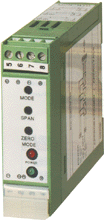| Back to CD |
|
Back to WELCOME Page |
| Back to CD |
|
Back to WELCOME Page |

RTD TYPE (ALPHA: DIN or SAMA)
SENSOR LEADS
Signal Output
Temperature Range
Sensor Break (Output)
Scale: C or F
The MCR-RTD module configuration software is capable of storing configurations of all of the modules I/O data. A simple print command produces a label for the module's current configuration. The onboard Intel processor is capable of addressing RTDs not currently offered.
A highly accurate delta-sigma processor, analog to digital converter, assures precise temperature conversion over a wide or narrow temperature span. All MCR-RTD module outputs are linearized and scaled by the Intel microcontroller, which yields an approximate 12 bits of outputs resolution. A combination of through hold and surface mount technology provides stable low drift temperature processing even in harsh industrial environments. MCR-RTD modules snap onto standard 35 mm flat DIN-rail and utilize the unique 'COMBICON' terminal block for module wiring.
Module Isolation
The MCR-RTD modules are available in isolated or nonisolated versions. The
isolated MCR-RTD modules feature a combination of optical and transformer
isolation. The optical isolation provides common mode voltage (CMV) isolation
up to 1 kV between the sensor input and process signal output. The module's
power supply is isolated from the process signal output by a DC/DC transformer
isolation circuit. Isolation assures that there will be no measurement
errors introduced by currents that are developed by sensor to measurement
impedance differences.
Surge & Short Circuit Protection
The MCR-RTD module is designed for use in industrial environments. Stringent
IEC testing has shown that the MCR-RTD modules pass the IEC 801.2
(Electrostatic Discharge) and IEC 801.4 (Electrical Fast Transient/Burst)
tests. Suppressor diodes protect both input and output circuits from wiring
errors and shorting.
Inputs
The MCR-RTD can accept a wide variety of standard RTD sensor types. Platinum
and nickel RTDs are standard. Special alphas are available as long as a DIN or
SAMA reference is available for the desired RTD type. 2, 3 or 4-wire RTD sensor
configurations are possible options for the MCR-RTD module. 2, 3 and 4-wire RTD
configurations require both software and hardware adjustments. A maximum input
lead resistance of 200 ohms can be handled by the sensor input circuit.
The RTDs sensor input is digitized to a 24 bit resolution and then is read by the on board Intel 8752 microcontroller. The Intel processor is equipped with an integrated memory that contains programming, sequencing, scaling and linearization routines. Once programmed, all user configurations are stored in the microcontrollers EEPROM (Electrically Erasable Read Only Memory). All user configurations are retained in the EEPROM even after the 24 V dc module power supply is disconnected.
Computer Configuration
To configure the MCR-RTD temperature signal conditioning module. The
configuration software, MCR-CONF, must be used. The MCR-CONF includes a
programming manual, programming software and interface programming cable, and
module labels to place on the module once the configuration has be completed.
Any standard IBM PC or compatible computer with an Intel 80286 or better
microprocessor is capable of operating the MCR-CONF software. An EGA or VGA
color graphic card, serial port COM1 or COM2, 384 kbytes of free memory and DOS
versions 3.2 or higher are
the remaining software/hardware requirements.

Copy (to your hard drive) the MCR-RTD configuration software now!
View an Adobe Acrobat pdf file for more
product info (requires Acrobat Reader).
|
| |||||